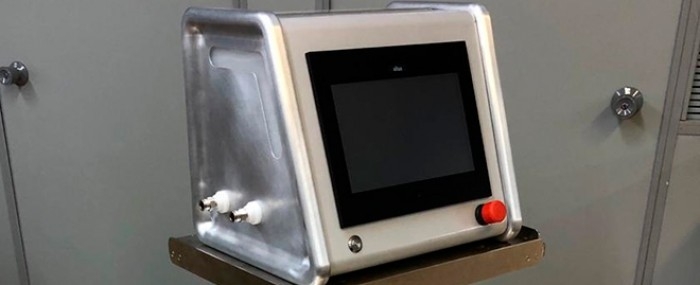

Machines designed and prototyped by Setup Automação with PIPE-FAPESP’s support could come to market costing 25% less than currently available devices (photo: Setup)
Machines designed and prototyped by Setup Automação with PIPE-FAPESP’s support could come to market costing 25% less than currently available devices.
Machines designed and prototyped by Setup Automação with PIPE-FAPESP’s support could come to market costing 25% less than currently available devices.

Machines designed and prototyped by Setup Automação with PIPE-FAPESP’s support could come to market costing 25% less than currently available devices (photo: Setup)
By Eduardo Geraque | FAPESP Innovative R&D – The Brazilian firm Setup Automação e Controle de Processos, based in Campinas (São Paulo state, Brazil), has developed two mechanical ventilator prototypes that cost less to produce than the devices already on the market.
The ventilators are being developed as part of a project supported by the FAPESP Innovative Research in Small Business Program (PIPE) (read more at: agencia.fapesp.br/33433).
The project was one of these selected in a call for proposals issued by PIPE-FAPESP in partnership with FINEP, the Brazilian Innovation Agency, in March 2020 to fund the development of products, services and processes to combat COVID-19 by startups and small technology companies in the state of São Paulo.
“We’ve successfully developed two prototypes, and we’re now negotiating with two companies to bring the machines to market,” says William Robert Heinrich, one of the owners of the firm.
According to Heinrich, the ventilators could sell for up to 25% less than those commercially available now. Less reliance on imported components is one of the factors that have lowered the cost. “About 70% of the components we’re using in these ventilators are locally produced,” he says.
One of the machines is for emergencies and the other model, more robust and with more capabilities, is for critical patients in intensive care units (ICUs). Both will be built on the same production platform created by the firm’s engineers.
“The platform lets us vary the mechanical and pneumatic parts of the machines. The difference between them resides in the software we’ve developed,” Heinrich explains.
Besides cost, low noise and weight (16 kg) are also competitive advantages of the firm’s ventilators over those already on the market.
The engineers initially planned to use automotive injector nozzles because they are cheap and produced in clean rooms, but this idea was abandoned because they are too noisy. “The solution we found to this problem has made our ventilators quieter than most. Their weight is also among the lightest on the market,” Heinrich says.
The machines have a battery lasting six hours, and can therefore be used by hospitals in remote areas, as well as field hospitals and other emergency facilities. They also have other attractive features. The ICU model, for example, matches a longstanding wish of doctors and nurses for simplification of procedures. “In a survey of critical care professionals we conducted, we discovered that the ventilators currently being used in ICUs hinder the treatment of intubated patients who suffer cardiac arrest. The patient has to be disconnected from the endotracheal tube in order to be resuscitated,” Heinrich says.
The endotracheal tube remains in the patient’s windpipe but is disconnected from the ventilator so that a defibrillator can be used or CPR (cardiopulmonary resuscitation) performed. Meanwhile, an additional intensivist is required to connect a self-refilling bag valve mask to the endotracheal tube and provide support to patient’s breathing that must be synchronized and intercalated with CPR procedure. “This takes up a lot of time, which is obviously a critical factor in an emergency,” Heinrich said.
The firm’s engineers addressed this issue by developing an emergency button that puts the ventilator into a special operating mode within milliseconds. “The emergency button eliminates the need to disconnect the endotracheal tube in order to use a bag valve mask and have two intensive care professionals resuscitate an intubated patient after cardiac arrest,” Heinrich says.
Market expansion
With a 24-year track record in industrial automation, where it has consistently innovated in areas such as pneumatics, mechanics, hydraulics, and closed-loop control, the firm has presented to prospective partners all the costs involved and the procedures required to win approval for the ventilators from regulators such as ANVISA (health surveillance) and INMETRO (weights and measures).
“Our business model will be technology transfer in exchange for payment of royalties,” Heinrich says.
Scant investment in ventilators and the fact that most machines are practically obsolete in Brazil point to a sizable potential market even leaving aside the huge extra demand due to the pandemic. “Market research shows that the last time Brazil invested significantly in ventilators was in 2010 when 65,411 machines were bought for about US$68 million. In 2020, only 15,235 were purchased,” Heinrich says.
Brazil now has roughly 80,000 mechanical ventilators, some 80% of which are ten years old, according to surveys by the firm.
Republish
The Agency FAPESP licenses news via Creative Commons (CC-BY-NC-ND) so that they can be republished free of charge and in a simple way by other digital or printed vehicles. Agência FAPESP must be credited as the source of the content being republished and the name of the reporter (if any) must be attributed. Using the HMTL button below allows compliance with these rules, detailed in Digital Republishing Policy FAPESP.




